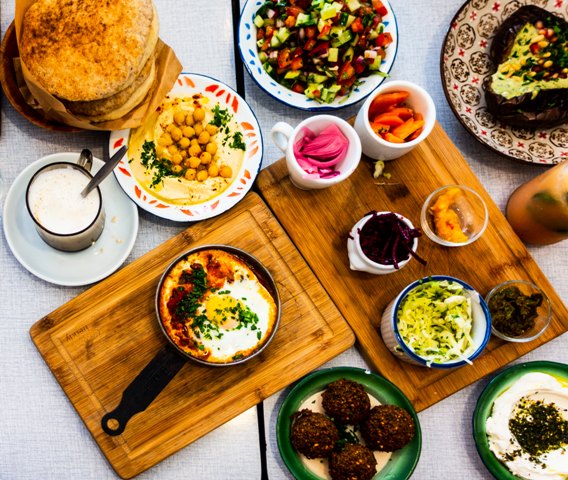CSR: Corporate Volunteer Programs
Companies spend a huge chunk of their revenue in training their employees in soft skills like team work, adaptability, problem solving, leadership development programs, etc. which increase employee engagement, foster a feeling of belonging and lead to overall development of an individual. These skills can be acquired by starting a Corporate CSR Volunteer Program.
Here are 4 ways in which Corporate Volunteer Programs are better than the ongoing training programs:
- Improved collaboration among team members:
Volunteer programs help develop the community and in doing so, bring together people from different teams, backgrounds and generations to work together towards one goal – Betterment of the community. Such scenarios are very difficult to create in the corporate office. The teams know that they are making a real difference and hence everyone works towards the same goal which is precisely the aim of the training programs.
- Leadership Development:
Volunteering brings people out of their cocoon and some people really shine in the leadership role, an opportunity which they might not have at work. Managers who are also part of these programs are around to observe the display of such talent and hence leverage the skills of the people in the office environment.
- Employee Retention
People inherently want to do good and when they get an opportunity to bring about a change in their community through corporate volunteering initiatives, it creates a bond between the employee and the company. This leads to happier employees and hence higher employee retention
- Good Public Relations
Volunteering is a good PR exercise for corporates even if the above three good virtues are completely ignored. When corporates bring about a change in the community through their volunteer programs, they do get brownie points.
Volunteerism is a boon that not only will lead to development of the values corporates desire in their employees but also lead to overall development of the company as well as community at large.
Thank you for reading the story until the very end. We appreciate the time you have given us. In addition, your thoughts and inputs will genuinely make a difference to us. Please do drop in a line and help us do better.
Regards,
The CSR Journal Team
सीएसआर फंड का गड़बड़झाला, स्टेचू ऑफ़ यूनिटी में हुआ घोटाला?
जिस पटेल ने देश की आज़ादी के बाद सियासतों के बीच रियासतों को भारत का अभिन्न हिस्सा बनाया, जिसने एक श्रेष्ठ भारत का सपना दिखाया, जिसने देश को अखंड बनाया, ऐसे वीर सपूत प्रणेता सरदार पटेल को देश याद करते हुए उनके सम्मान में विश्व की सबसे बड़ा मूर्ति का निर्माण हुआ, लेकिन जो विश्व में अनोखी है, जो दुनिया में कहीं नहीं है, जिसने मूर्तियों के सारे रेकॉर्ड तोड़ दिए, सरदार वल्लभ भाई पटेल की प्रतिमा ‘स्टैच्यू ऑफ यूनिटी’ स्थापित करने के लिए सरकारी कंपनियों से मिली रकम पर ही सीएजी ने सवाल खड़े कर दिए है।
बड़े पैमाने पर सरकारी तेल कंपनियों ने अपने सीएसआर फंड का यहाँ दुरूपयोग किया है, सारे नियमों को ताक पर रखकर माननीय नरेंद्र मोदी जी को खुश करने के लिए सरकारी कंपनी का खजाना खोल दिया, सीएसआर फंड इस्तेमाल समाज के विकास और उन तबकों के विकास और उत्थान के लिए होना चाहिए जिससे कुछ बदलाव लाया जा सकें लेकिन सरकारी कंपनियों ने तो सीएसआर फंड का इस्तेमाल सीएसआर के नियमों के विरुध्द ही कर डाला।
दरअसल गुजरात में नर्मदा के मुहाने पर स्थापित सरदार वल्लभ भाई पटेल की 182 फुट ऊंची प्रतिमा स्टेच्यू ऑफ यूनिटी पर कैग ने घोटाला खोला है। कैग ने स्टेच्यू के लिए सरकारी कंपनियों की ओर से कॉरपोरेट सोशल रेस्पॉन्सिबिलिटी यानी सीएसआर के तहत धनराशि उपलब्ध कराने को गलत बताया है और इसे निर्धारित प्रावधानों का उल्लंघन करार दिया है।
नियंत्रक एवं महालेखा परीक्षक यानी कैग की संसद में पेश एक रिपोर्ट में कहा गया है कि 31 मार्च 2017 को खत्म हुए वित्त वर्ष में प्रतिमा और संबंधित स्थल का निर्माण करने के लिए पांच केंद्रीय सार्वजनिक उपक्रमों ने 146.83 करोड़ रुपए की फंड सीएसआर के तहत मुहैया कराई है। इनमें से तेल व प्राकृतिक गैस निगम ने 50 करोड रुपए, हिन्दुस्तान पेट्रोलियम निगम लिमिटेड ने 25 करोड़ रुपए, भारत पेट्रोलियम निगम लिमिटेड ने 25 करोड़ रुपए, इंडियन ऑयल निगम लिमिटेड ने 21.83 करोड़ रुपए, और ऑयल इंडिया लिमिटेड ने 25 करोड़ रुपए की रकम दी है।
कैग रिपोर्ट के अनुसार सभी कंपनियों ने इस सीएसआर फंड को राष्ट्रीय ऐतिहासिक परिसंपत्तियों, कला व संस्कृति का संरक्षण के तहत दर्शाया है। कैग का कहना है कि इस परियोजना में कंपनियों के योगदान को कंपनी अधिनियम 2013 की सातवीं अनुसूची के अनुसार सीएसआर नहीं माना जा सकता क्योंकि यह ऐतिहासिक परिसंपत्ति नहीं है।
गुजरात सरकार ने सरदार पटेल की याद में प्रतिमा बनाने के लिए सरदार वल्लभभाई पटेल राष्ट्रीय एकता ट्रस्ट संगठन की स्थापना की है। इस संगठन ने स्टेच्यू ऑफ यूनिटी परियोजना की शुरुआत की। 30 अक्टूबर 2018 को एक भव्य कार्यक्रम के दौरान प्रधानमंत्री नरेंद्र मोदी ने इस मूर्ति का अनावरण किया। 2989 करोड़ की लागत वाली इस मूर्ति को बनाने के लिए ठेका अक्टूबर 2014 में लार्सन एंड टूब्रो को दिया गया।
परियोजना के तहत सरदार पटेल की 182 फुट ऊंची कांस्य प्रतिमा का निर्माण भले ही आज देश का विदेशों में शान बढ़ा रहा है लेकिन इस परियोजना के साथ ऐसा शब्द जुड़ गया जो जब भी स्टेचू ऑफ यूनिटी का नाम लिया जाएगा तो सीएसआर फंड घोटाला का भी नाम साथ जोड़ा जाएगा।
आज देश को, समाज को सीएसआर फंड की उन इलाकों में ज्यादा जरूरत है जहां आज भी बच्चें कुपोषण से मर रहे है, जहां स्कूलों के आभाव में बच्चों को शिक्षा नही मिल पा रही है, जहां लोगों के स्वास्थ्य का सवाल है, जहां आज भी लोगों को स्वच्छ पानी की एक बूंद नही मिल रही है, ऐसे में इन सरकारी आयल कंपनियों को दुबारा सोचना चाहिए, हम और हमारा देश तभी गौरान्वित करेगा जब ये करोड़ों का फंड सही हाथ में जायेगा और इसका इस्तेमाल सही तरीके से किया जाएगा।
8 Principles To Improve Your Digestion
Just as disease would quickly grow in our brick home if the rubbish was only occasionally emptied, so disease would quickly spread throughout the human body if the rubbish were not emptied daily. Proper digestion ensures daily motions.
Food transit time from entry to exit should be no longer than 24 hours. Ideally, it should be 16 hours. To encourage regular evacuation, follow these 8 principles that govern the colon:
1. Be Consistent
The human machinery runs according to cycles as does the planet. It responds well to regularity. Rise and retire at the same time every day. Eat and drink at the same time every day. This will encourage regularity in evacuation times. The colon loves consistency.
2. Promptly Answer Nature’s Call
Resisting this call leads to many colon problems. When the sigmoid section of the colon is full, the feeling to pass motions is felt. If this call is not heeded, the content falls back into the previous section of the colon. The body’s garbage disposal unit has not been allowed to empty and the contents begin to rot and ferment further. The blood supply to the colon is massive and this putrid condition is conveyed by the blood to every part of the living machinery.
3. Drink 2-3 Litres of Water Daily
One of the main functions of the colon is to take water out so that stools can be formed and passed out of the body. If the body does not receive two to three litres of water daily, it becomes dehydrated. In a state of dehydration, the body takes more fluid out of the colon than usual to compensate and so the stools become drier and harder, resulting in constipation.
4. Eat High-Fibre Foods
Fibre is vital to the colon to ensure that the many folds and bends in the colon are swept out. Refined foods turn into a clay-like substance that can easily get caught and wedged in these grooves. Fruits, vegetables, nuts and grains are all fibre-rich, with fruit and vegetables having the highest concentration for good digestion.
5. Relax
Don’t hurry the visit to the toilet. Relax: the emptying of the body’s major garbage disposal unit is an important part of the day.
6. Breathe with the Abdominal Muscles
The abdominal muscles were designed to aid in breathing. When these muscles are used, the diaphragm presses down on the stomach which in turn presses into the colon, thus both major organs are massaged via breathing. This massaging gently stimulates peristalsis, aiding digestion.
7. Chew, chew, chew
Food should be thoroughly masticated to enable the whole digestive tract to utilise the food properly. This produces a substance which is less abrasive and with an easier transit time through the colon.
8. Eat Cultured Foods
To function properly, the colon requires a correct balance of intestinal flora. Refined foods, especially sugar and antibiotics, destroy this balance. Cultured foods – sour dough bread, sauerkraut, yoghurt, miso and tofu are examples. They encourage the growth of healthy bacteria in the colon which is essential for a correct balance of intestinal flora, and consequently, proper digestion.
3 top tips for those with digestion issues
1. Place a castor oil poultice on the abdomen overnight, four nights a week. Dampen double thickness cloth with castor oil. Place over abdomen. Cover with plastic and hold in place with snug-fitting underpants or adhesive tape. This poultice can be used for a couple of weeks as the oil is not drawing, but penetrating to cleanse and decongest.
2. Once a day sit in a tub of water heated to 40°C for 5 minutes, then sit in a tub of cold water for 15-30 seconds. Immerse your feet in a tub of hot water (at 40°C) to complete the treatment.
3. Get an enema.
This article has been issued in public interest as part of a series on natural healing.
CSR: Dealing With Diabetes Naturally
According to the WHO data, India has the highest number of Diabetes patients in the world. In the year 2000, there were about 31.7 million diabetics in India. This number is expected to increase by 100% in the year 2030 accounting to 79.4 million patients.
Diabetes is a chronic disease where the patient’s body struggles to control its blood glucose level. This condition may cause heart disease, kidney failure, blindness or amputations.
It is not easy to manage diabetes. The patient needs to constantly check their diet for even the simplest of healthy foods can affect the sugar level in blood at a great extent. In the extreme cases, one cannot do without western medicine. However, at the initial stage when the body becomes insulin resistant, there are certain foods that can be consumed in order to avoid the development of type 2 diabetes.
- Turmeric:
Turmeric is 100% effective in preventing Diabetes. According to a study, curcumin, an active compound in dry turmeric is 500 to 100,000 times more effective than the prescription drug Metformin at activating glucose uptake.
- Ginger:
According to a study, researchers have proved that consuming 1600 mg of ginger per day improves eight markers of diabetes.
- Cinnamon
Cinnamon is one of the oldest and most popular spices used for its flavouring and medicinal qualities. Cinnamon is known to normalise blood sugar levels in type 2 diabetes patients by improving the ability to respond to insulin.
- Berries
Studies have shown that berries reduce the insulin spike after the meal. The starch in the bread alone can spike the after meal glucose levels. Eating berries requires less insulin to control it.
- Chia seeds
Chia seeds are extremely high in fibre, which does not raise blood sugar. The fibre actually helps lower the blood sugar by slowing down the rate at which the food moves through the gut and gets absorbed.
- Bitter Gourd Juice
Bitter Gourd juice is an excellent beverage for diabetics. According to studies, bitter gourd has a few active substances with anti diabetic properties. One of them is charantin, which is known for its blood glucose lowering effect. Another substance is Polypeptid – p, also known as p-insulin for its insulin like properties which can control diabetes naturally.
This article has been issued in public interest as part of a series on natural healing.
Thank you for reading the story until the very end. We appreciate the time you have given us. In addition, your thoughts and inputs will genuinely make a difference to us. Please do drop in a line and help us do better.
Regards,
The CSR Journal Team
CSR: Biodiversity and our Daily Bread
“Biodiversity” is a fairly recent word, used for the first time in a publication by entomologist Edward O. Wilson in 1986. It tends to be of interest to only a few people, mainly those who study it.
In reality it refers to a simple concept, relevant to everyone on the planet, because it is nature, it is life itself and it is the diversity of life, on many levels, from the smallest (genes, the building blocks of life) to plant and animal species, up to the most complex levels (ecosystems). All these levels intersect, influence each other and evolve.
Scientists at the University of Stanford have compared the species and varieties of an ecosystem to the rivets that keep an airplane held together. If we start removing rivets, for a while nothing will happen and the airplane will continue to operate. But little by little the structure will weaken and, at a certain point, removing just one more rivet will cause the plane to crash.
In the history of the planet, everything has a beginning and an end, and in every era, many species have become extinct. But never at the horrifying rate of recent years, one that is a thousand times greater than previous eras.
Following a comprehensive study, this year the University of Exeter in England declared that earth is undergoing its sixth mass extinction (during the fifth, 65 million years ago, the dinosaurs disappeared). There is a substantial difference between this and the extinctions of the past: the cause. For the first time, humankind is responsible.
Humans continue to destroy rainforests, cement over the land, pollute the water and soil with chemical pesticides and fertilizers and accumulate plastic in the oceans. And they insist on marginalizing the earth’s last custodians: those small-scale farmers, herders and fishers that understand and respect the fragile equilibrium of nature.
If biodiversity disappears, what will happen to our food?
Together with wild flora and fauna, many plants domesticated by man and animal breeds selected for their milk or meat will also disappear. According to the FAO, 75% of edible plant varieties have been irreversibly lost. In the United States the figure is 95%. Today 60% of the world’s food is based on three cereals: wheat, rice and corn. Not on the thousands of rice varieties selected by farmers that once were cultivated in India and China, or on the thousands of varieties of corn that were grown in Mexico, but on the few hybrid varieties selected and sold to farmers by a handful of multinationals.
The international grassroots organisation Slow Food is putting in place projects to protect biodiversity around the world. To preserve the wealth of domesticated biodiversity, Slow Food created the Ark of Taste, which collects plants, animals and food products (breads, cheeses, cured meats etc) at risk of extinction that belong to the culture, history and traditions of communities around the world.
Another initiative that directly involves the food producers is the Presidia. Presidia are projects that take concrete action to safeguard a traditional food (an Ark product), a traditional technique (for fishing, farming, food processing, cultivation, etc), a rural landscape or an ecosystem.
The battle to save biodiversity is not just any battle. It is a battle for the future of the planet.
Every one of us can do something, in our local area, every day.
Thank you for reading the story until the very end. We appreciate the time you have given us. In addition, your thoughts and inputs will genuinely make a difference to us. Please do drop in a line and help us do better.
Regards,
The CSR Journal Team
CSR: Efforts To Have A Pollution Free Diwali
Diwali is one of the most celebrated festivals in India. With the custom of bursting crackers as part of celebrations, Diwali and pollution unfortunately go hand-in-hand. The air pollution statistics in India are alarming as it is. The festival often makes things worse.
There are certain things that can be done to reduce air and noise pollutionand go green during Diwali. However, with fireworks and crackers being freely available, these recommendations have not been widely accepted. It has also hurt the religious sentiments of many Hindus in the country.
There have been several campaigns by the government, corporates, NGOs as well as individuals to spread awareness about the pollution caused by crackers. Some of these campaigns shed light on the problem in hand.
Airtel started a campaign called ‘Bring back our stars’ last year. It talked about how the children of today, living in big metropolis like Mumbai or Delhi are unable to see the stars at night. Stargazing is one of nature’s most magical phenomena, that hildren are missing out on.
Vodafone India had started a campaign to promote a green Diwali by distributing super crackers to its customers. The ‘Super Crackers’ contained eco-friendly water soluble papers that carry different varieties of seeds of plants with air-purifying characteristics.
Since 1985, the residents of Ganakkuchi village in Assam have been making ‘toobris’ or flower pots with a traditional formula that’s low on noise, non-flammable, has no chemicals, but turns Diwali into a starry night. According to Assam’s Pollution Control Board, these indigenous fire crackers are less polluting compared to those available in the market.
Big Bazaar’s ‘Pataka’ campaign of 2015 showed a DIY cracker made out of plain paper. It is basically a paper folded in a certain way, which would make a noise resembling a fire cracker when jerked. This way, there is no pollution but the children can enjoy.
Nahar group has initiated the green Diwali campaign by encouraging its residents to burst balloons instead of crackers. This might be good for the air, but it would still generate a lot of balloon waste.
The government has struggled in dealing with this population by banning the fire crackers last year, and limiting the time to use crackers for two hours this year. However, there has not been a full proof solution to this problem.
The CSR Journal wishes you have a happy, safe and pollution free Diwali followed by a prosperous New Year!
Thank you for reading the story until the very end. We appreciate the time you have given us. In addition, your thoughts and inputs will genuinely make a difference to us. Please do drop in a line and help us do better.
Regards,
The CSR Journal Team
How to Keep the Stomach Happy
The stomach is an often-neglected organ, yet our temperament and our mental powers largely depend on it. A happy stomach produces a happy disposition. A sour stomach produces a sour disposition.
As with every part of the living machinery there are laws that govern the stomach. Adhering to these laws ensures that the stomach works well and this in turn affects the whole of this living organism.
The five areas we have control over with the stomach concerns the gateway of the stomach: the mouth.
1. Watch what goes in
Raw food is live food and thus it is full of enzymes. Because of this, it is digested easily and quickly in the stomach. Cooked food is also an important part of the diet as the cooking process breaks down the starches and phytic acid in many foods such as grains and legumes, making them more digestible. Sprouting and culturing also can do this.
Cooked food takes longer to digest than raw food and so it is advisable to always begin your meal with raw food. This stimulates the digestive enzymes well and prepares them for the cooked grub. It also allows the raw food to digest and pass through the stomach without being delayed by the cooked food, which has a slower passage.
The food requiring the least preparation is the food to eat largely and the food requiring the most preparation is the food to eat less of.
Keep fruit and vegetables separate. Have fruit at one meal and vegetables at the next. Fruits and vegetables require different enzymes to break them down. If eaten together they can create a ‘war’ in the stomach.
Water should be drunk between meals and not with meals. If liquid is taken with meals, the digestive enzymes are diluted and thus are unable to break down the food effectively. Digestion is a chemical process and water slows down all chemical processes.
Avoid putting articles into the stomach that would irritate or weaken it. Foods that weaken and irritate the stomach lining are: alcohol, sugar, MSG, caffeine, chilies, cloves, fried foods, tobacco and marijuana smoke.
Food that has been cooked and kept more than 24 hours, such as old, devitalized food is detrimental. Grains and legumes that have not been thoroughly cooked are also inhibitors to digestion.
2. Observe when it goes in
Be consistent. We are creatures that run according to cycles and the stomach is no exception. It loves to eat at the same time every day.
The stomach is better prepared for a large meal at breakfast than at any other time of the day. We should eat breakfast like a king, lunch like a queen, tea like a pauper.
When we lie down to sleep, the stomach should have its work all done, that it, as well as the other organs of the body, may enjoy rest.
At least five or six hours should intervene between meals and most people will find two meals are better than three. Some people, because of the demands of work or home situations, require a third meal. If this is the case, it should be taken early and be the lightest meal of the day. Digestion slows down after 7pm at night.
Digestion can be likened to an explosion on the human body as it takes an enormous amount of blood and energy to digest food. Food averages three to four hours to digest. If this process is interrupted, the stomach once again has problems breaking the food down properly.
A common but detrimental practice is to eat every two or three hours; when this happens, the stomach is required to cease from digesting and go to the new comer. Thus digestion is delayed and the food that is neglected begins to ferment.
All the digestive enzymes are depleted after digestion and so a period of rest is needed between meals for the stomach to replace supplies.
3. How long does food stay in the mouth?
You may have heard the wise old saying ‘We should chew our drink and drink our food.’ This means that we should keep our fluids in our mouths, or ‘chew’ them a few seconds before swallowing so that the fluid is warmed before entering the stomach.
If you are juicing, this allows the salivary enzymes to mix with the juice so that the very small amount of digestion that is required for juices happens thoroughly and quickly.
The meaning of this saying when applied to food is that we should chew our food until it is almost a liquid. This not only makes digestion easier for the stomach because the food is broken up into tinier pieces, causing a larger surface area for digestive enzymes to work on, but it allows for the starch enzyme, ptylin, to begin breaking down the starch in the mouth.
In short, chew, chew, chew.
4. How much food goes in?
Even organic, properly prepared food can turn to poison if too much is taken into the stomach at one time. As several small meals a day weakens the stomach by retarding proper digestion, so overeating twice a day also retards digestion by overloading the stomach. 1.5-2 litres is the maximum amount that the average human stomach can safely hold. Any more places a burden on the stomach.
5. Change the environment
Meal times should be happy times. The stomach is closely related to the brain. Discuss no controversial issues at the dinner table.
If little children are removed from the table every time they make a fuss, they quickly learn to behave at meal times.
It is a good idea to only eat lightly or have a juice instead of a meal if you are anxious. Digestion is retarded when the human machinery is stressed.
Do not feel hurried, but eat slowly with cheerfulness.
Gentle exercise like walking, or light domestic duties after meal aids digestion. Strenuous physical exercise retards digestion by pulling away blood from the stomach to the muscles that are being used. Depletion of blood supply retards digestion.
Posture. The back should be straight and the shoulders back which enables the stomach to perform its work digestion without being cramped.
This article has been issued in public interest as part of a series on natural healing.
Lights Up – It’s Diwali!
Diwali, known as the festival of lights, is a major festival in India. This festival symbolises the victory of good over evil. Hence, it is celebrated with people spreading as much joy as they can around them. This is why in this festive season, the activities and initiatives pertaining to Citizen Social Responsibility and Corporate Social Responsibility are popular.
For Diwali 2018, corporate India has taken to impacting as many lives as they can through CSR.
Surachand village in Rajasthan is known as the village of diya makers. This is the village which makes and supplies clay lamps for Diwali celebration throughout the country. Ironically, the village that contributes majorly in lighting up the country during the festival of lights, did not have constant power supply. Cadbury Celebrations took up the task to provide electricity to this village by installing solar panels there.
PwC India Foundation recognised the need of electricity in the villages in Pali district of Rajasthan. The foundation provided public lighting in the form of solar street lights in the Khariya Sodha village of Rajasthan. This was done to enhance the lives of the local community and make solar lighting a more acceptable way to eradicate light poverty.
Spicejet airlines has committed to provide public lighting to a village in Assam as part of its CSR initiative this Diwali. The airline aims to provide sustainable energy access through solar micro-grid to the people for a period of 75 days.
Thank you for reading the story until the very end. We appreciate the time you have given us. In addition, your thoughts and inputs will genuinely make a difference to us. Please do drop in a line and help us do better.
Regards,
The CSR Journal Team



















